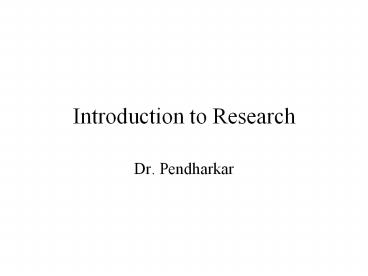Introduction%20to%20Research - PowerPoint PPT Presentation
Title:
Introduction%20to%20Research
Description:
Involves study of employee attitudes and behaviors towards IT. ... Objectivity, Generalizability and Parsimony. Hypothetico-Deductive Method ... – PowerPoint PPT presentation
Number of Views:13
Avg rating:3.0/5.0
Title: Introduction%20to%20Research
1
Introduction to Research
- Dr. Pendharkar
2
Research
- Systematic and organized effort to investigate
specific problem. - Research process involves well-thought-out and
carefully executed activities.
3
Management Info. Sys. Research
- Involves study of employee attitudes and
behaviors towards IT. - Involves impact of IT on management practices,
employee lifestyle, strategy formulation, and
decision making.
4
Types of Research
- Problem Solving Research/Applied Research
(specific to a particular problem) - Theoritical Research/Fundamental Research (adds
to the general body of knowledge in a particular
area).
5
Fundamental Research
- The fundamental research relates to understanding
phenomena and problems that occur in several
organizations and how they can be solved. - To understand the phenomena and build theories
based on research results.
6
Hallmarks of Research
- Purposiveness
- Rigor
- Testability (Hypothesis)
- Replicability
- Precision and Confidence
- Objectivity, Generalizability and Parsimony
7
Hypothetico-Deductive Method
- This approach involves starting with a
theoritical framework, formulating hypotheses,
gathering data and analyzing it to test the
hypotheses.
8
Hypothetico-Deductive Method
- Observation (new behaviors, attitudes, and
feelings surfacing in an environment). - Preliminary information gathering (unstructured,
structured interviews and library search) - Theory formulation, Hypothesizing
- Data collection, analysis and deduction
9
Research Process
- Identify a research problem either through
literature review or through interviews - Identify factors that have been known to have
impact on the problem - Ensure that all factors impacting the problem are
considered
10
Research Process
- Identify the dependent variable (variable of
primary interest) - Identify the independent variable
- Identify moderating variable (if any)
- Develop hypotheses
11
Exploratory Study
- Used to comprehend the nature of the problem
- Conduct extensive unstructured and structured
interviews to understand the problem - Develop theories and test hypotheses as a follow
up
12
Hypotheses Testing
- Try to explain the nature of certain
relationships and differences among the groups - Causal study When a researcher attempts to find
the cause of a problem - Correlational Study Identify important variables
associated with the problem (study variance)
13
Study Setting
- Non-contrived Setting Research done in natural
environment where events happen naturally - Contrived Setting Research is done in lab
setting
14
Unit of Analysis
- Individual
- Dyads (boss-subordinate)
- Groups (Group performance)
- Organizations
- Cultures
15
Time Horizon
- Cross-Sectional Studies
- Longitudinal Studies
16
Sampling
- In order to increase validity of the research, a
random sample of subjects is chosen - Internal Validity vs. External Validity
17
Factors Affecting Internal Validity
- History
- Maturation Effects
- Testing Effects (pre-test post-test)
- Instrumentation Effects
- Selection Bias
- Mortality
18
Experimental Designs
- Pretest Posttest experimental design (OXO)
- Post test only Experimental and Control Groups (X
O) ( O) - Pre-test Post-test Experimental and Control
Groups (O X O) (O O)































